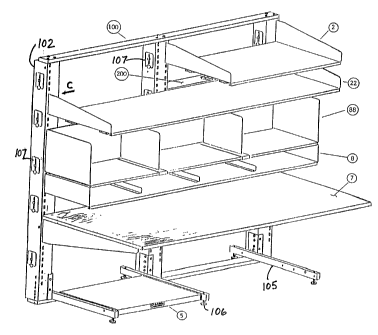Some of the information on this Web page has been provided by external sources. The Government of Canada is not responsible for the accuracy, reliability or currency of the information supplied by external sources. Users wishing to rely upon this information should consult directly with the source of the information. Content provided by external sources is not subject to official languages, privacy and accessibility requirements.
Any discrepancies in the text and image of the Claims and Abstract are due to differing posting times. Text of the Claims and Abstract are posted:
| (12) Patent: | (11) CA 2173799 |
|---|---|
| (54) English Title: | RACK SYSTEM FOR SUPPORTING ELECTRONIC EQUIPMENT |
| (54) French Title: | SUPPORT MODULAIRE POUR MATERIEL ELECTRONIQUE |
| Status: | Deemed expired |
| (51) International Patent Classification (IPC): |
|
|---|---|
| (72) Inventors : |
|
| (73) Owners : |
|
| (71) Applicants : |
|
| (74) Agent: | RIDOUT & MAYBEE LLP |
| (74) Associate agent: | |
| (45) Issued: | 2001-12-25 |
| (22) Filed Date: | 1996-04-10 |
| (41) Open to Public Inspection: | 1997-10-11 |
| Examination requested: | 1998-10-20 |
| Availability of licence: | N/A |
| (25) Language of filing: | English |
| Patent Cooperation Treaty (PCT): | No |
|---|
| (30) Application Priority Data: | None |
|---|
A modular rack system is provided for supporting
electronic equipment, comprising vertical and lateral frame
members cooperating to form a vertical supporting frame,
and shelf or rack members supported from a front of the
frame for carrying the electronic equipment, wherein the
vertical and horizontal frame members comprise channel
members with walls defining continuous longitudinal
openings at a rear of the frame and cooperating to form a
system of interconnected raceways for receiving cables for
forming connections to and between the electronic
equipment, the walls of the channel shaped members defining
ports for passing end connectors of cables. Preferably the
channel section members are closed at the rear by doors,
and the cable ports are closed by removable cover plates.
The horizontal channel section members are located so as to
line up with cable ports in the vertical members, while the
vertical members may be provided with internal brackets for
power bars.
Système de stockage modulaire conçu pour loger de l'équipement électronique comprenant des éléments de châssis verticaux et latéraux, qui forment un châssis de support vertical, et des étagères ou des éléments de support fixés sur le devant du châssis pour soutenir l'équipement électronique. Les éléments verticaux et horizontaux comprennent des canalisations dont les parois sont munies d'ouvertures longitudinales sur toute leur longueur, formant ainsi, à l'arrière du châssis, un système de canalisations intereliées conçues pour recevoir les câbles, qui permettent d'établir des connexions avec l'équipement électronique et de relier les différents appareils entre eux. Les parois des éléments en forme de canalisation sont dotées de points de connexion par lesquels on peut insérer les connecteurs d'extrémités des câbles. De préférence, les éléments en forme de canalisation sont fermés à l'arrière par des portes et les points de connexion sont fermés par des plaques de fermeture amovibles. Les éléments horizontaux en forme de canalisation sont alignés avec les points de connexion des éléments verticaux, tandis que les éléments verticaux peuvent ou non être dotés de fixations internes pour blocs d'alimentation à prises multiples.
Note: Claims are shown in the official language in which they were submitted.
Note: Descriptions are shown in the official language in which they were submitted.

For a clearer understanding of the status of the application/patent presented on this page, the site Disclaimer , as well as the definitions for Patent , Administrative Status , Maintenance Fee and Payment History should be consulted.
| Title | Date |
|---|---|
| Forecasted Issue Date | 2001-12-25 |
| (22) Filed | 1996-04-10 |
| (41) Open to Public Inspection | 1997-10-11 |
| Examination Requested | 1998-10-20 |
| (45) Issued | 2001-12-25 |
| Deemed Expired | 2008-04-10 |
There is no abandonment history.
| Fee Type | Anniversary Year | Due Date | Amount Paid | Paid Date |
|---|---|---|---|---|
| Application Fee | $0.00 | 1996-04-10 | ||
| Maintenance Fee - Application - New Act | 2 | 1998-04-14 | $100.00 | 1998-04-09 |
| Request for Examination | $400.00 | 1998-10-20 | ||
| Maintenance Fee - Application - New Act | 3 | 1999-04-12 | $100.00 | 1999-04-12 |
| Maintenance Fee - Application - New Act | 4 | 2000-04-10 | $100.00 | 2000-04-10 |
| Maintenance Fee - Application - New Act | 5 | 2001-04-10 | $150.00 | 2001-03-05 |
| Final Fee | $300.00 | 2001-10-01 | ||
| Maintenance Fee - Patent - New Act | 6 | 2002-04-10 | $150.00 | 2002-01-14 |
| Maintenance Fee - Patent - New Act | 7 | 2003-04-10 | $150.00 | 2003-04-10 |
| Maintenance Fee - Patent - New Act | 8 | 2004-04-13 | $200.00 | 2004-06-30 |
| Expired 2019 - Late payment fee under ss.3.1(1) | 2004-11-02 | $50.00 | 2004-06-30 | |
| Maintenance Fee - Patent - New Act | 9 | 2005-04-11 | $400.00 | 2006-04-10 |
| Maintenance Fee - Patent - New Act | 10 | 2006-04-10 | $250.00 | 2006-04-10 |
Note: Records showing the ownership history in alphabetical order.
| Current Owners on Record |
|---|
| HULL, LESLIE |
| Past Owners on Record |
|---|
| None |